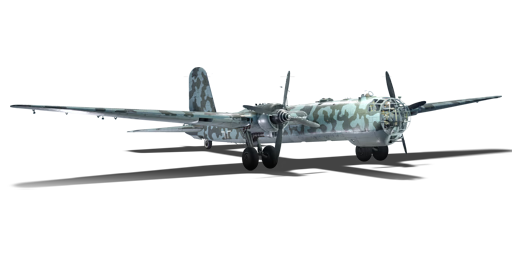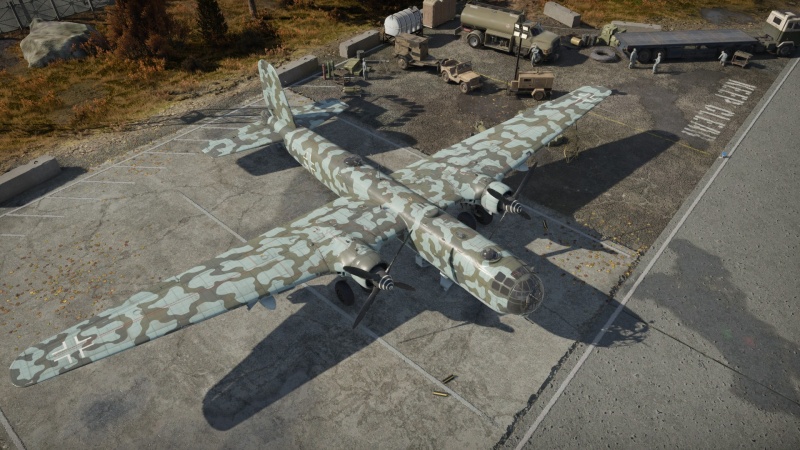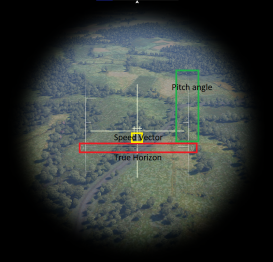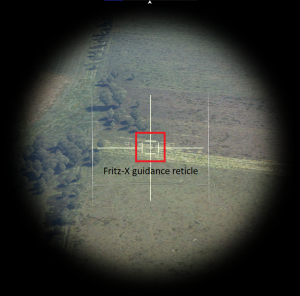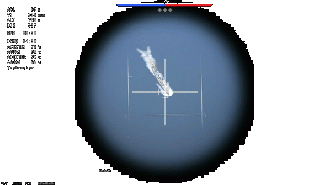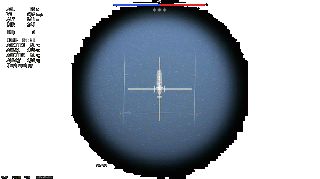He 177 A-5
Contents
- 1 Description
- 2 General info
- 3 Armaments
- 4 Usage in battles
- 5 History
- 6 Media
- 7 See also
- 8 External links
Description
The He 177 A-5 is a rank German bomber with a battle rating of (AB), (RB), and (SB). It was introduced in Update 1.77 "Advancing Storm" as part of the revenue share program. It was created by Daniil "Joy_Division__" Zaytsev.
The Heinkel He 177 A-5 is a heavy bomber that excels at destroying stationary targets such as pillboxes and bases from altitude. Its speed allows to bomb one base or two before confronting any enemy plane and then withdrawing back in shallow dive. Even if an enemy is trying to intercept you, your defensive armament in manual mode would keep it at bay.
Although the He 177 A-5 looks like a twin-engine bomber, it has the power of a four-engined bomber, because the DB 610 engine is actually made up of two DB 605 engines coupled together to turn a single propeller.
General info
Flight performance
| Characteristics | Max Speed (km/h at 6,500 m) |
Max altitude (metres) |
Turn time (seconds) |
Rate of climb (metres/second) |
Take-off run (metres) | |||
|---|---|---|---|---|---|---|---|---|
| AB | RB | AB | RB | AB | RB | |||
| Stock | 531 | 518 | 32.2 | 33.4 | 5.9 | 5.9 | 1,600 | |
| Upgraded | 582 | 555 | 29.8 | 31.0 | 10.5 | 8.0 | ||
Details
| Features | ||||
|---|---|---|---|---|
| Combat flaps | Take-off flaps | Landing flaps | Air brakes | Arrestor gear |
| ✓ | ✓ | ✓ | X | X |
| Limits | ||||||
|---|---|---|---|---|---|---|
| Wings (km/h) | Gear (km/h) | Flaps (km/h) | Max Static G | |||
| Combat | Take-off | Landing | + | - | ||
| 431 | 406 | 280 | ~4 | ~1 | ||
| Optimal velocities (km/h) | |||
|---|---|---|---|
| Ailerons | Rudder | Elevators | Radiator |
| < 300 | < 310 | < 360 | > 715 |
| Compressor (RB/SB) | ||
|---|---|---|
| Setting 1 | ||
| Optimal altitude | 100% Engine power | WEP Engine power |
| 5,700 m | 2,520 hp | 2,797 hp |
Survivability and armour
- 9 mm Steel plates in pilot's seat
- 7 mm Steel plate under the entire cockpit
- 9 mm Steel plate in front of the front dorsal gunner
- 7 mm Steel plates on cockpit roof around front dorsal gunner
- 7 mm Steel plates around rear dorsal gunner
- 7 mm Steel box in front of the rear dorsal gunner
- 57 mm Bulletproof glass in front of tail gunner
- 9 mm Steel plates around the bottom and front of tail gunner
- Self-sealing fuel tanks (2 in frontal fuselage, 2 in central fuselage, 2 in each wing)
Modifications and economy
Armaments
Suspended armament
The He 177 A-5 can be outfitted with the following ordnance:
- 48 x 50 kg SC50JA bombs (2,400 kg total)
- 12 x 250 kg SC250JA bombs (3,000 kg total)
- 6 x 500 kg SC500K bombs (3,000 kg total)
- 4 x 1,000 kg SC1000L2 bombs (4,000 kg total)
- 2 x 1,800 kg SC1800B bombs (3,600 kg total)
- 2 x 1,800 kg SC1800B bombs + 6 x 500 kg SC500K bombs (6,600 kg total)
- 3 x 1,400 kg PC 1400 X (Fritz X) bombs (4,200 kg total)
Defensive armament
The He 177 A-5 is defended by:
- 1 x 20 mm MG 151 cannon, chin turret (300 rpg)
- 1 x 20 mm MG 151 cannon, tail turret (800 rpg)
- 2 x 13 mm MG 131 machine gun, front dorsal turret (1,000 rpg = 2,000 rpg)
- 1 x 13 mm MG 131 machine gun, rear dorsal turret (1,000 rpg)
- 1 x 13 mm MG 131 machine gun, ventral turret (1,000 rpg)
- 1 x 7.92 mm MG 81 machine gun, nose turret (1,000 rpg)
Usage in battles
He-177 A-5 as a strategic bomber
Combining the speed and handling of the Do 217 and the immense payload of the Lancaster along with defensive armament approaching that of the American bombers, the He 177 Greif is an outstanding heavy bomber. Its max payload of 2 x 1,800 kg and 6 x 500 kg bombs is easily the best of its contemporaries when it comes to demolishing bases in AB and airfields in RB/SB. Other payloads are quite useful depending on the bombing objectives in RB/SB: 6 x 500 kg against bases (3 per bases), 4 x 1000 kg and 2 x 1800 kg for aircraft carriers and airfields.
The He 177 bears some similarities to the Do 217 series. It has an exceptionally high dive speed for a heavy bomber and is capable of reaching up to 700 km/h in a dive. It is, however, more manoeuvrable at high speeds, one has to be careful not to overload the wings. The two engines (which are really two V12 DB 605 engines coupled together to drive one four-bladed propeller, making them essentially 24 cylinder engines) are very powerful, but at the same time more vulnerable to damage.
The defensive armament of the Greif is very good by German standards, consisting primarily of 13 mm MG 131 heavy machine guns, completed with 2 MG 151/20 cannons, one in front and one in tail turret. The large tail fin prevents the dorsal turrets from firing directly to the rear, leaving only the MG 151/20, however.
He-177 A-5 as a tactical bomber
The He-177 is the second and final aircraft of the German tech-tree to have access to the PC1400 X Fritz-X radio guided bomb. Compared to the He 111 H-6, the He-177 can carry three individual drop Fritz-X compared to a single one. The access to guided munitions make this the first actual high-altitube tactial bomber (tactical bombing is aerial bombing aimed at targets of immediate military value such as combatants) as it can strike moving targets with pin-point accuracy even from high altitude. In other words, the Fritz-X offers the pilot a wide variety of possible engagements.
Climbing and bombing
The He 177 A-5 will spawn at 4.5 km as a long-range bomber and as such, it's much easier to get out the reach of interceptors. Do some side climbing, reach 5,000 m after game start (speed will decrease to 250 km/h, but still fine) and continue with a 5-degree climb. Remember, this aircraft is not a dive bomber and should not be treated as such.
In order to do side climbing, you should upgrade the engine parts and then, just go as soon as possible to the ETC 1000/I module. After this upgrade, you will be able to carry 4 x 1,000 kg bombs which can be used to destroy up to 4 bases (no external wing carried bombs here).
After upgrading engine parts and getting ETC 1000/I, it's time to climb and boom. Just go for the nearest base after reaching +6,000 m altitude. Then, it's done. Be careful of enemy interceptors which may snake their way up to your altitude, because you are really vulnerable at low speeds, hence the recommendation to side-climb. Side-climbing will help pilot have enough time to reach high altitudes, and lay in a bombing run.
Some notes:
- You should use combat flaps when bombing airfield to decrease speed (there's a chance of not hitting the airfield)
- Protect your aircraft as the repair costs are 40,000 Silver Lions.
- Losing one flap will cause instability, just be careful!
Flight paths and engagement paths
There are multiple rules which should be followed when flying the He-177 in order to prevent and counter a wide variety of threats. The first and pretty straight forward rule is stay out of Line of Sight (LOS). This is one of the most basic rules for any aircraft in the game, but specially due to the size of the He-177, it is crucial as it is easier to spot a 2-engine bomber at distances than a single-prop aircraft. The He-177 is far from being the easiest plane to conceal, but due to its camouflage, it can become invisible to eye sight if whoever is the threat falls in the trap. Do not rely on the camouflage to conceal you most of the time, it depends on the LOS azimuth, distance and enemy pilot's awareness. The blue colour is reliable on both sea and land environments (specially in winter maps) although it is not recommended to rely on it in Realistic or Arcade battles as, once the aircraft is detected, a marker will appear on the He-177 revealing the position. Depending on the situation and gamemode, there are multiple environmental hiding places which can make the He-177 have a safe flight to the target zone, this will be divided into Optical Hiding and Technological Hiding. Both of them are to be complimented by each other, the pilot must not focus on just one or the other. Both have to be done at the same time in order to achieve the best survivability in game.
Optical Hiding
Pretty straight forward, hide the aircraft from enemy LOS. These hiding spots could be doing a "grass-cutting" flight path (flying as close to the ground as possible), flying behind any sort of environmental obstructions (mountains, inside canyons, inside river banks, etc) or a really high altitude flight. Due to the air spawn capabilities, flight ceiling, cruising speed and battle-rating, the He-177 has a much better survivability at high altitudes, mainly for the fact it lacks maneuverability and agility due to having a massive wingspan but having very capable and powerful defensive capabilities.
Technological Hiding
By this term, we are talking about hiding yourself against all sorts of airborne and surface based detection systems. While the He-177 is located at 6.0, there are various platforms that have search radar.
Technological Hiding – Airborne radars
While it is unlikely for the He-177 to encounter an airborne radar aircraft (only aircrafts that can be encountered in a "normal basis" are the P-61C-1, P-61A-1, F6F-5N which are in the ranges of 4.0-5.0), all He-177 should remain alert for airborne detection radars. In case the He-177 is playing in a game past 7.0, aircrafts like the Sea Venom FAW 20 are going to be seen.
Technological Hiding – Ground based radars
It is highly unlikely to face a search/track radar while on a normal basis of a 6.0 game when being used in ground battles. However, it may encounter search/track radars past 7.7 (more specifically at 8.0 and beyond). While this will not happen on a normal basis, players take the He-177 as a strategic bomber to destroy targets from high altitudes using the powerful Fritz-X (see Fritz-X combat).
The story changes here, in naval battles, it is somewhat common to encounter search/track radars. The He-177 will start encountering vessels such as the HMS Tiger, SKR-7, Spokoinyy, MPK Pr.12412, Bezuprechny, etc. All of these vessels are able to detect and effectively destroy the He-177 at a decent range. However, these chances will be reduced if the pilot flies at high altitude (preferably past 4km). The main advantage of this is that it reduces the AAA accuracy. Now, the drawbacks from flying higher are not as significant compared to when trying to evade ground based radars and wanting to engage.
Hiding against them can be tricky depending on the purpose of the aircraft, in this case, it is strategic bombing with Fritz-X. Hiding from radar is the easiest as cluttering is enough to cause detection issues (refer to Airborne radars for further explanation of airborne radars and the following explained terms). If the pilot is facing aircraft with airborne radars, the best way to counter is flying low or behind environmental obstructions. Flying high can be a double edge sword depending on the distance, altitude, radar scan pattern and azimuth. Flying extremely high can make the aircraft invisible to enemy radars, both ground based and airborne (ground based get a max range of 15 km detection range at most), depending on the other players, but doing a low flight path ensures key points which are vulnerabilities.
Bomb sight reticle, guidance and use
As the rest of the bombers, the bomb sights are the main aiming tool for delivering ordnance in Air Realistic battles and Simulator. Depending on the speed of the aircraft, flight attitude and flight altitude, the bomb sight may look different. Now, let's take into consideration the fact that the bomb sights while using Fritz-X do vary, and we will study the composition of the bomb sight and how it works. You may have already noticed the Fritz-X reticle has what we have seen in default bomb sights with an added "box". Now, this new box is how we will aim the Fritz-X. But before anything, make sure to set your guidance keybinds to the most comfortable keybinds, for default, it is Alt+WASD.
Dropping bombs with bomb sights is easy: fly towards target/wait for target to be on crosshair or compensate for speed and drop time if target is moving/drop. While this is true for the Fritz-X, the story somewhat changes. Hitting moving targets with the Fritz-X is much easier than with dumb bombs. However, it should be noticed that the white box marks the limit of where the bomb can be guided and when the bomb hits the ground. What does this mean? If we look at the following GIFs, we can see exactly how it works. The box is actually an overlapping cross. As the bomb falls down and gets closer to the ground, the box will start to close and overlap with the crosshair forming a cross as well, it should be noted that, as the box closes, the guidance area is reduced. After it has successfully hit the ground, the reticle will change to the default bombing reticle (as seen in GIFs).
Fritz-X combat
Now we are using the Fritz-X, giving it the purpose it is intended to do. The Fritz-X is a powerful bomb with a somewhat awkward mass (1570kg) but this does not affect the performance. The Fritz-X is very good at what it does but some aspects must be taken into consideration before fighting with it. First of all, the Fritz-X is a guided glide bomb, it does not have any rocket assistance or anything like that. The "rocket" like smoke is given by a flare used to guide the bomb. Second, the Fritz-X speed is dependent on the carrier's initial speed. If the He-177 is flying at 400 km/h then the bomb will have 400 km/h as initial speed and gradually increase speed as it falls down. Third, the range of the bomb depends on the altitude of the carrier. Now that we have cleared these three main aspects to take into consideration while using the Fritz-X, let's move to using the Fritz-X for ship hunting.
This can be quite a fun tactic if carried out properly. There is nothing more pleasing than watching the Fritz-X hitting a ship followed by smoke, a fireball and the powerful explosion sound it generates. Taking out the fact that cruisers and battleships are very dangerous due to their superb anti-air capabilities, you cannot hit them everywhere. If you want to maximize the effectiveness of the Fritz-X, make sure to aim at the right spots. The first spot (as seen in Fritz-X vs Cruiser gif) is the Center Of Mass. The reason to pick COM over turrets which can initiate an ammo explosion is that due to the Fritz-X not being a kinetic penetration based bomb, it solely relies on penetrating by the explosive power. Now, cruiser decks might not be heavily armored, but a cruiser has many decks, meaning the bomb will loose penetration and explosive power as it moves down. Usually the turrets will be destroyed with the ammo elevators. Situationally the ammo racks will be lit on fire but there will be no critical/fatal damage to the ship's integrity. Aiming at the COM does three main things: destroys exhaust funnels, damages or destroys engines and destroys two or more crew compartments. As seen in the gif, we can see how a perfectly fine cruiser gets it's crew lowered from 100% to 58%. This number can vary depending on exactly where the bomb hits, but it will often take at least 40% of the crew. Pretty impressive, right? Now, the same applies to battleships. However, in this case, battleships tend to have an extra that potentializes the fatal damage made to it. Most battleships tend to have secondary or tertiary ammo racks at about the COM of the ship, meaning a COM hit will cause even more damage that what was seen in the cruiser proportionally. As expected, you are not able to one-shot a battleship or cruiser with the Fritz-X. However, you can cripple them to battleship armor-piercing salvo levels or even higher with just a single bomb. The second spot is below the waterline, as we have seen in other bombs, below the waterline explosions tend to do significant damage, but in this case, a COM hit will do much more.
As expected, a bomb with an explosive mass of 320kg is more than likely to cause fatal damage to this type of ship. And that exactly happens. However, while lightly armored vessels tend to be one-shotted by nearly all types of hits, medium armored destroyers tend to take one or more bombs if they are not aimed properly. To ensure a one-shot for any of these vessel types, we will do the opposite of what we did to cruisers and battleships. We will not aim for COM but turrets. The reason to aim for turrets even if aiming for turrets reduces the fatal damage is because when it comes to destroyers the number of decks is significantly reduced as well as the armor. The explosive penetration will have no efforts in hitting the ammo racks whatsoever and causing major flooding, significant crew loss and well, an ammo explosion followed by scorching fires. As seen in the gif, we can see how a perfectly fine destroyer gets annihilated by a single bomb which is quite an impressive sight to witness. It is actually not that impressive as other bombs tend to do that as well, but with the rest of the bombs, having an ammo rack hit is a very challenging job. The Fritz-X makes that task easier, but still, it is a challenge in it's own. Now, we do not need to talk about smaller and lighter armored vessels. We all know what a ton bomb will do to them, now imagine a ton and a half guided bomb to the ammo rack or even the COM. This makes the Fritz-X one hell of a bomb, a guided munition to dominate the waters and state who rules the seas.
Manual Engine Control
| MEC elements | ||||||
|---|---|---|---|---|---|---|
| Mixer | Pitch | Radiator | Supercharger | Turbocharger | ||
| Oil | Water | Type | ||||
| Not controllable | Controllable Auto control available |
Controllable Auto control available |
Controllable Auto control available |
Separate | Not controllable 1 gear |
Not controllable |
Pros and cons
Pros:
- Heavy defensive weaponry with accurate 13 mm and 20 mm turrets
- Plenty of bomb load options, with a maximum bomb load of four 1,000 kg bombs
- Can carry all 4 x 1,000kg SC1000L2 bombs in the bomb bay, so He 177 A-5 can get 3-4 bases at first spawn in realistic battles
- One of only three heavy bombers for Germany, and the only high-rank heavy bomber in the tech tree
- Capable of speeds of up to 530 km/h or 340 mph in level flight
- First spawn at long-range bombers' altitude, which will help get altitude over interceptors and other fighters
- Good climb rate, can easily make it to 6.5 km altitude
- Dual engine aerodynamic, make it quite manoeuvrable for a heavy bomber
- Combat flaps are really useful for decreasing airspeed
- Fritz X guided bomb is very effective against destroyers and other slow-moving ships (drop from +2,000 m)
- High SL multiplier, very good money making
Cons:
- Plane is vulnerable in frontal engagement due to the absence of copilot and the glazed nose
- Engines overheat very quickly when activating WEP and when the cooling system is empty
- Vulnerable from side attacks
- Expensive repair cost for RB and higher than average on AB and SB
- No air brakes for a heavy bomber which increases landing difficulty
- Being a heavy bomber means that you can't take off from medium airfields
- Quickly overheats above 5,500 m
- Engines oil cooler and flaps are vulnerable against machine guns fire
- Incapable of flying with one engine only, will keep losing altitude and eventually will have to land or crash
- Incredibly expensive repair cost, 50,000+ SL in RB when fully upgraded
History
Development of the He 177 began in 1936 as part of the Bomber A specifications issued by the German Air Ministry (RLM). The specifications called for a long-range, high-speed bomber with a payload of 1,000 kg. Despite the very demanding specifications, Heinkel began working on a mockup which was submitted for review in late 1937, with an order for 12 experimental machines following shortly after in early 1939. However, throughout its development, the He 177 suffered from a range of problems, some of which weren't even fixed before further development stopped. For example, one of the requirements (which was soon rejected, since it was impossible to implement) from the Air Ministry was the ability to bomb from a dive, that's why the engineers had to make various workarounds to provide the required flight technical characteristics. To reduce aerodynamic drag and to ensure flight range, two DB 601 engines were installed in pairs on one gondola and worked with a common shaft which rotated one four-bladed propeller. Thanks to this it was possible to create the aircraft using a two-engined scheme. But for this reason, the vehicle suffered from severe engine overheating issues and more often than not experienced mid-flight engine failures and frequent fires. In the process of fine-tuning the aircraft, the weight was significantly increased, so it became necessary to install a massive frame which could not be hidden - a relatively thin wing or tightly packed nacelles wouldn't fit. As a result, each frame was divided into two racks, each with a single wheel that could be retracted into the wing on opposite sides of the nacelle.
By 1944, development of the He 177 was considered finished, but by that time, the fortune of war had already turned on Germany and the need for a complex strategic bomber had faded. Nonetheless, over 1,000 He 177s were produced across several variants, with most machines seeing action on the Eastern front. However, despite being made in large numbers, the aircraft ultimately failed to make a difference in the war's outcome as its design maturity came too late, although some of the built vehicles were also used after war's end.
- From Devblog
Media
See also
Links to the articles on the War Thunder Wiki that you think will be useful for the reader, for example:
- reference to the series of the aircraft;
- links to approximate analogues of other nations and research trees.
External links
- [Devblog] Heinkel He 177 A-5 Greif: The Flaming Arrow
- Official data sheet - more details about the performance
| Heinkel Aircraft Company (Heinkel Flugzeugwerke) | |
|---|---|
| Fighters | He 51 A-1 · He 51 B-1 · He 51 B-2/H · He 51 C-1 · He 51 C-1/L |
| He 100 D-1 | |
| He 112 A-0 · He 112 B-0 · He 112 V-5 | |
| Jet fighters | He 162 A-1 · He 162 A-2 |
| Twin-engine fighters | He 219 A-7 |
| Bombers | He 111 H-3 · He 111 H-6 · He 111 H-16 |
| He 115 C-1 | |
| He 177 A-3 · He 177 A-5 | |
| Export | He 112 B-1/U2(Hungary) · He 112 B-1/U2(Romania) · He 112 B-2/U2 · A7He1 |
| T 2 | |
| Germany bombers | |
|---|---|
| Arado | Ar 196 A-3 |
| Blohm & Voss | BV 138 C-1 · BV 238 |
| Dornier | Do 17 E-1 · Do 17 Z-2 · Do 217 E-2 · Do 217 E-4 · Do 217 K-1 · Do 217 M-1 |
| Focke-Wulf | Fw 189 A-1 · Fw 200 C-1 |
| Henschel | Hs 123 A-1 |
| Heinkel | He 111 H-3 · He 111 H-6 · He 111 H-16 · He 115 C-1 · He 177 A-3 · He 177 A-5 |
| Junkers | Ju 87 B-2 · Ju 87 R-2 · Ju 87 R-2 Libya · Ju 87 D-3 · Ju 87 D-5 · Ju 88 A-1 · Ju 88 A-4 · Ju 188 A-2 · Ju 288 C |
| Messerschmitt | Me 264 |
| Savoia-Marchetti | ▀S.M.79 serie 1 · ▀S.M.79 B · ▀S.M.79 serie 4 · ▀S.M.79 serie 8 |
| ▀S.M.79 AS · ▀S.M.79 bis/N · ▀S.M.79 bis/T.M | |
| Trophies | ▀Wellington Mk Ic |


